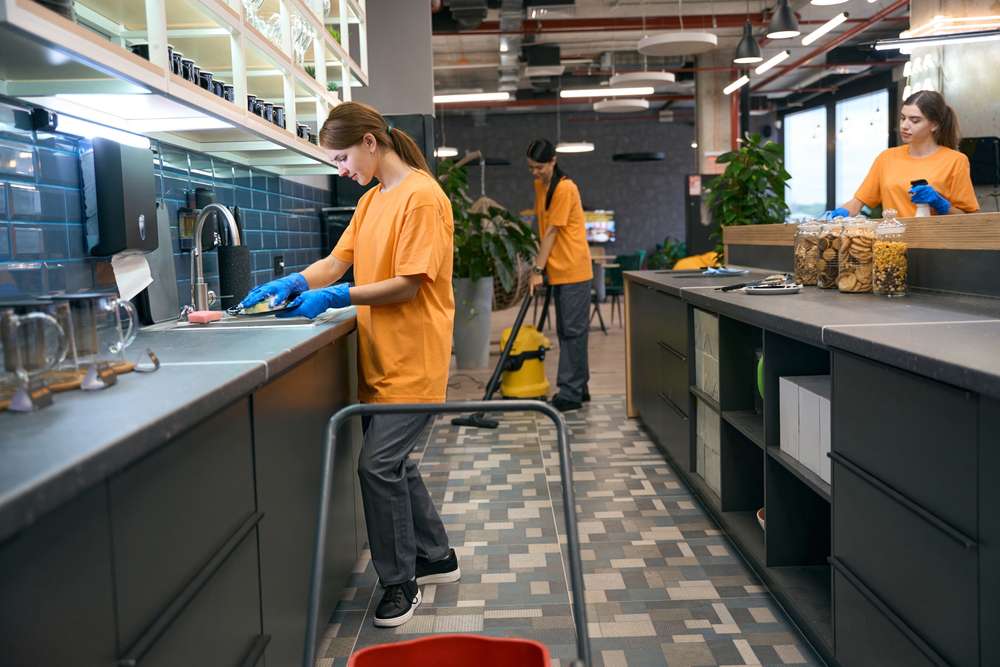The Ultimate Guide to Daily Commercial Kitchen Cleaning
Maintaining impeccable cleanliness in a commercial kitchen is essential. Daily commercial kitchen cleaning is not just a chore. It’s a fundamental practice that ensures hygiene, food safety, and the smooth flow of culinary operations.
In this comprehensive guide, we’ll discuss the benefits of a daily cleaning routine, walk you through the necessary supplies and equipment, and detail the step-by-step process to keep your commercial kitchen gleaming.
Benefits of a Daily Cleaning Routine
Before diving into the specifics, let’s understand why a daily cleaning routine is essential for your commercial kitchen:
1. Prevents Cross-Contamination
Regular cleaning and sanitizing of surfaces and equipment prevent the spread of harmful bacteria and allergens, ensuring the safety of your customers and staff.
2. Ensures Food Quality
A clean kitchen environment minimizes the risk of food contamination and spoilage, upholding the quality and taste of your culinary creations.
3. Improves Efficiency
Clean and organized workstations enhance the efficiency of your kitchen staff. They can focus on cooking rather than searching for utensils or navigating cluttered spaces.
4. Maintains Equipment
Daily cleaning extends the lifespan of your kitchen equipment by preventing the accumulation of grease and grime, which can damage machinery.
5. Passes Health Inspections
Health inspectors routinely visit commercial kitchens to assess cleanliness and compliance with food safety regulations. A daily cleaning routine ensures you’re always ready for an inspection.
Gather Necessary Supplies and Equipment
To begin your daily kitchen cleaning journey, you’ll need a set of reliable supplies and equipment:
- Cleaning Agents: Gather commercial kitchen cleaners, disinfectants, and degreasers suitable for different surfaces.
- Sanitizing Solutions: invest in food-safe sanitizing solutions to eliminate bacteria and pathogens on food contact surfaces.
- Cleaning Tools: Equip your cleaning arsenal with scrub brushes, scrub pads, microfiber cloths, and sponges.
- Mop and Bucket: A durable mop and a bucket for water and cleaning solution are essential for floor cleaning.
- Broom and Dustpan: Ensure you have a sturdy broom and dustpan for sweeping up debris.
- Trash Bags: Keep an ample supply of trash bags on hand for waste disposal.
- Safety Gear: Safety should never be compromised. Supply your team with gloves, aprons, and eye protection.
Cleaning Countertops and Surfaces
1. Clear the Area
Begin by clearing countertops and work surfaces of any loose items, including dishes, utensils, and equipment.
2. Dust and Debris Removal
Use a dry cloth or sponge to remove any loose dust and debris from surfaces.
3. Cleaning Solution
Apply an appropriate cleaning solution to the surface and allow it to sit for a few minutes to break down grease and grime.
4. Scrubbing
Scrub the surface with a brush or scrub pad to remove stubborn stains or residue.
5. Rinse
Wipe the surface with a damp cloth to remove the cleaning solution, and then dry it with a clean, dry cloth.
6. Sanitize
Finish by sanitizing the surface with a food-safe sanitizing solution. Follow the manufacturer’s instructions for proper dilution and contact time.
Cleaning Appliances and Equipment
1. Unplug Appliances
Before cleaning, ensure that all appliances are unplugged to prevent accidents.
2. Remove Detachable Parts
Take off any detachable parts such as racks, trays, and shelving for separate cleaning.
3. Dust Removal
Use a dry cloth or brush to remove dust and debris from the exterior and interior of appliances.
4. Cleaning Solution
Apply a suitable cleaning solution to the exterior and interior surfaces.
5. Scrubbing
Use a scrub pad or brush to scrub away grime and stains. Pay special attention to areas prone to grease buildup.
6. Rinse and Dry
Wipe away the cleaning solution with a damp cloth and then thoroughly dry the appliance.
7. Replace Parts
Reassemble the appliance with the cleaned detachable parts.
Sweeping, Mopping, and Sanitizing Floors
1. Sweep First
Begin by sweeping the entire kitchen floor to remove loose debris, food particles, and dust.
2. Mop Preparation
Prepare a bucket with water and an appropriate floor cleaning solution. Make sure to follow the manufacturer’s dilution instructions.
3. Mopping
Mop the floor, starting from one corner and working your way toward the exit. Be sure not to leave standing water, as it can be a slip hazard.
4. Sanitizing
After mopping, sanitize the floor with a food-safe sanitizing solution. Ensure it’s mixed according to the manufacturer’s recommendations.
5. Drying
Allow the floor to air dry or use dry mops or cloths to speed up the drying process.
Cleaning Cooking Equipment
1. Prepare the Equipment
Ensure that the equipment is switched off and unplugged before cleaning.
2. Dust Removal
Use a dry cloth to remove any dust and debris from the equipment’s exterior.
3. Cleaning Solution
Apply a suitable cleaning solution to the exterior surfaces of the equipment.
4. Scrubbing
Use a scrub pad or brush to remove grime, particularly around knobs, handles, and seams.
5. Rinse and Dry
Wipe away the cleaning solution with a damp cloth, then thoroughly dry the equipment.
6. Inspect and Replace
Inspect the equipment for any issues, such as loose parts or damage, and address them promptly.
Cleaning Refrigerators & Freezers
1. Remove Contents
Before cleaning, empty the refrigerator and freezer of their contents.
2. Unplug
Unplug the refrigerator and freezer to ensure safety during cleaning.
3. Interior Cleaning
Wipe down the interior with a mixture of warm water and a mild detergent, paying attention to spills and stains.
4. Shelves and Drawers
Remove shelves and drawers and clean them separately with a suitable cleaning solution.
5. Exterior Cleaning
Clean the exterior of the refrigerator and freezer using a solution suitable for the material. Pay attention to handles and controls.
6. Rinse and Dry
Wipe away cleaning solution residues with a damp cloth, then dry the interior and exterior.
7. Replenish and Plug In
Once everything is clean and dry, replenish the refrigerator and freezer with food items and plug them back in.
Contact Us For Commercial Kitchen Cleaning Near You
Daily commercial kitchen cleaning is the foundation of a clean, efficient, and safe kitchen environment. It ensures that your kitchen adheres to the required hygiene and safety standards while maintaining the overall quality of your restaurant’s offerings.
By following the step-by-step cleaning process outlined in this guide, you can streamline your daily cleaning routine, maintain your kitchen equipment, and safeguard the health of your customers and staff.
Or contact Safe Kitchens for the best commercial kitchen cleaning service in Los Angeles. With a clean and well-organized kitchen, you can focus on what truly matters: creating culinary masterpieces that delight your patrons.

